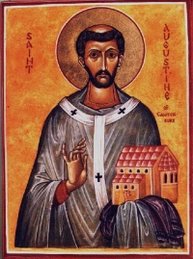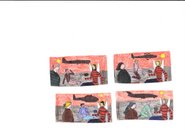
Book Review:
To Quell the Terror: The Mystery of the Vocation of the Sixteen Carmelites of Compiègne, Guillotined July 17, 1794, by William Bush
Previously reviewed HERE.
July 17, 2007 marks the 213th anniversary of the execution of the Discalced Carmelite Nuns of Compiègne during the French Revolution’s Reign of Terror.
I have to agree with a friend's thought, that most saints who wear the martyr's crown did not receive it accidentally. Instead, martyrdom came as the culmination, or completion, of a life committed to the practice of 'death to self.' Saint Maximilian Kolbe is one saint who comes to mind. His volunteering to take the place of a married man who was to be starved to death was characteristic of a priest who had spent his life praying and working for the greater glory of God. The crowns of purity and martyrdom that he chose as a child were well-worn by the time he accompanied his fellow inmates into the cell where they were to be starved to death.
The Carmelite Nuns of Compiègne are a group of martyrs who also practiced 'death to self' as they went about a life of poverty, chastity, and obedience. The French Revolution and its subsequent Reign of Terror, combined with a prophetic dream of a nun more than a hundred years before, inspired them to make their deaths an offering, or holocaust, to end the Reign of Terror.
William Bush has written a thorough and inspiring book about the Carmelite Nuns. He describes the lives of the nuns at Compiègne (including a short biography of each) as well as describing the events which were taking place outside of the convent. These two stories connect the day that the nuns were ‘liberated’ from their cloister.
The most interesting part of Bush’s book is where he relates a mysterious vision experienced by a nun who lived at Compiègne approximately 100 years before the French Revolution. In the nun’s description of her vision, she told of a group of sisters she had never seen before who were called to ‘follow the Lamb.’ In this case the Lamb is presumably the Lamb of God, or Jesus Christ, and the nuns were to be martyred. This vision influenced the prioress to initiate the cloister’s offering up their lives to end the suffering of the people of France during the Revolution’s Reign of Terror.
William Bush wrote this book to correct the historical inaccuracies that have crept into the story of the Carmelite Martyrs of Compiegne. In particular, Gertrude le Fort’s book The Song at the Scaffold modified a lot of the events that took place during the Reign of Terror. George Bernanos, who wrote The Dialogue of the Carmelites, also romanticized some of the details of the story. The play by Poulenc, Dialogues of the Carmelites also changed the story in order to make a more dramatic opera. All three of these works presented the French Revolution in a romantic, sympathetic light, and that was one of the key things that Bush wanted to correct. The revolution was not a wonderful and liberating change in the history of Man. The people of France suffered tremendously under the new government which wanted to eliminate the influence of the Church in France. Many people – not just religious – lost their lives during the Terror.
This book is not just a history book. Mr. Bush makes some rather pointed comments about Divine Mercy, and how the nuns considered their martyrdom to be an offering accepted by God:
“Their final song at the scaffold…was Psalm 117, Laudate Dominum omnes gentes, which proclaims the mystic truth couched at the heart of the Christian experience of salvation: God’s mercy is at the center of all things, even of being guillotined.
Oh praise the Lord all ye nations!
Praise him all ye people!
FOR HIS MERCY IS CONFIRMED UPON US
And the truth of the Lord remaineth forever!
Praise the Lord!"
Pages 14-15.
This aspect of the book is what touched me the most, and makes this book one which I recommend without reservation. As a latecomer to praying the Chaplet of Divine Mercy, I was always struck by the last line of the final prayer, which refers to the Will of God as ‘Love and Mercy Itself.’ This prayer, and the final song of the Carmelites, remind me that whatever suffering comes my way should be looked upon as a gift from God – a cross to be accepted as necessary for my salvation.
This quote - and the final prayer of the Chaplet of Divine Mercy - have been a rich source of consolation for me during this past year.
As an aside, the cover of this book shows the opening scene from Poulenc’s opera Dialogues of the Carmelites. It always reminds me of the ordinations I have been to, where the candidates for priesthood start by lying prone on the altar – certainly symbolic of their death to self.


















1 comment:
Fabulous review!
Post a Comment